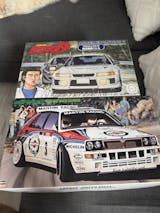When you think of the pinnacle of motorcycle racing in the late 20th century, the Yamaha YZR500 cannot be overlooked. It isn’t just a motorcycle; it’s a symbol of an era that showcased raw power, groundbreaking technology, and iconic racers. The 1988 YZR500 stands as a particularly significant model in this legendary lineage, combining innovative design with championship-winning performance.
A Brief History
The Yamaha YZR500 was part of Yamaha’s commitment to the premier class of motorcycle racing, the 500cc two-stroke Grand Prix Championship. The bike debuted in 1973 and evolved significantly over the years, with numerous iterations making their mark on tracks around the world. By 1988, Yamaha was determined to claim the World Championship title, and the YZR500 was the vehicle for that ambition.
Design and Features

The 1988 YZR500 was a stunning piece of engineering, built around a lightweight aluminum frame and powered by a potent 500cc two-stroke engine. This combination not only reduced the bike's overall weight but also contributed to its agility and speed on racetracks. The two-stroke configuration provided an exhilarating power band, allowing riders to feel a direct and immediate response to throttle inputs.
One of the critical features of the 1988 model was its sophisticated suspension system, which featured advanced components that offered both stability during high-speed cornering and excellent feedback for the rider. The bike also boasted cutting-edge aerodynamics for the time, with bodywork designed to reduce drag and improve downforce.
The Pioneering Riders

While the YZR500 was a formidable machine, its success was also attributed to the legendary riders who took the helm. One of the most notable was Wayne Rainey, an American racer who would go on to become a three-time World Champion. In 1988, Rainey piloted the YZR500, showcasing not only the capabilities of the motorcycle but also his exceptional skill and tactical prowess on the track.
Rainey’s rivalry with other noted riders, such as Kevin Schwantz and Eddie Lawson, added to the excitement of the 1988 season. These rivalries pushed both the riders and the machines to their limits, further enhancing the YZR500's legacy.

Championship Glory
The 1988 season was particularly thrilling, with the battles on the track intensifying as the season progressed. The bike’s reputation solidified itself in racing folklore, proving that engineering excellence and human talent could come together to create an unbeatable combination. The 1988 season would become a benchmark for Yamaha, inspiring future generations of racers and engineers alike.
Legacy and Impact
The Yamaha YZR500 1988 is not just a motorcycle; it is a piece of racing history. Its influence goes beyond mere specifications and accolades. The lessons learned from its design and performance shaped future models and revolutionized motorcycle racing.
The engineering achievements of the YZR500 paved the way for the development of newer four-stroke machines that dominate the MotoGP scene today. Its commitment to sportsmanship, innovation, and relentless pursuit of excellence became ingrained in Yamaha’s racing philosophy and continues to inspire their modern models.

The 1988 Yamaha YZR500 represents an era of raw adrenaline and fierce competition, capturing the hearts of motorcycle enthusiasts and racing fans alike. Its combination of cutting-edge technology, formidable design, and legendary riders ensures that it occupies a permanent place in the pantheon of motorcycle racing greatness. As we reflect on this iconic machine, we celebrate not just its accomplishments on the track but also the spirit of motorsport that it embodies—one of achievement, passion, and an endless quest for speed.














